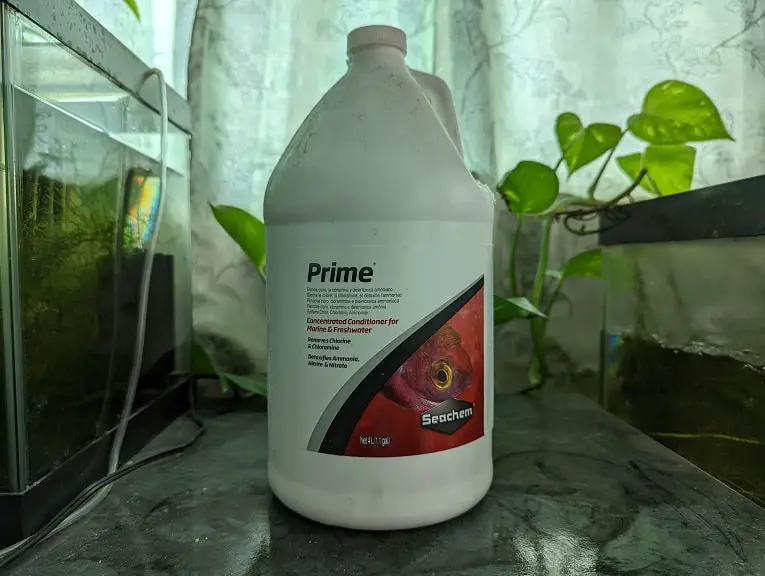The Seachem Prime and Seachem Stability are both designed to help improve the water quality of your fish tank. So, can you use both of these products together?
You can find out in this guide from Aquarium Blueprints.
Can you use Seachem Prime and Seachem Stability at the same time?
Seachem Prime is a water conditioner that will remove chlorine and chloramine from your tap water. It will also convert ammonia, nitrite and nitrate into a non-toxic state for up to 48 hours.
Seachem Stability adds spores that will eventually grow into live bacteria within 24 hours. These bacteria colonies will then establish themselves all of the surfaces in your tank. When established, they will consume ammonia, nitrites and nitrates.
Seachem Prime and Seachem Stability are safe to use at the same time. In fact, the two products complement each other pretty well if your goal is to prevent ammonia, nitrites and nitrates from harming your fish.
Prime will immediately convert any excess nitrogen compound into a non-toxic state for up to 48 hours. The bacteria colonies in your tank, as well as the ones introduced by Stability, will then feed on the non-toxic versions of the ammonia, nitrites and nitrates.

How to use Seachem Prime with Seachem Stability during a water change
In order to add Prime and Stability when doing a water change, we recommend taking the following steps:
1. First, remove the water from your aquarium. We recommend doing no more than a 20% water change over a 24-hour period so that you won’t stress out your fish with big changes to the water parameters.
2. Next, add Seachem Prime to your fish tank. The official dosage is 5 mL to treat 50 gallons of water.
3. Afterwards, you can add the new water into your tank.
4. Finally, add Seachem Stability to the aquarium. You should dose 5 mL for every 20 gallons of water.
5. If you are having issues with ammonia/or nitrite spikes, then we recommend adding the same amount of Prime every 48 hours to keep these compounds detoxified. You should also add more Stability every 24 hours until you have 0 ppm of ammonia and 0 ppm of nitrites.
6. If your nitrate level is beyond 40 ppm (or 20 ppm if you are keeping more sensitive species), then we recommend doing daily water changes until you get the concentration to safer levels.
How to use Seachem Prime with Seachem Stability when cycling a tank
To use Seachem Prime with Seachem Stability when you are cycling a tank, you can do the following:
1. Add the substrate, decorations, filter, air stone, heater, live plants into your tank if you haven’t done so already.
2. Next, you need to add water into your aquarium.
3. After adding water, you then need to add Seachem Prime (5 mL for every 50 gallons) to remove chlorine and chloramine. If you don’t remove these two chemicals, then your beneficial bacteria won’t be able to establish themselves in your tank.
4. After adding Seachem Prime to your aquarium, we recommend waiting a few minutes for the water conditioner to remove chlorine and chloramine.
5. Next, shake the bottle of your Seachem Stability to stir up the spores that may have settled at the bottom of the container.
6. You can then add Stability to your tank at 10 mL for every 20 gallons.
7. Finally, we recommend adding a pinch of fish food. The food will decompose into ammonia, which will kickstart the nitrogen cycle needed to grow the beneficial bacteria colonies.
8. Wait 24 hours.
9. After 24 hours, add another pinch of fish food and then add 5 mL of Stability for every 20 gallons.
10. Continue to add a pinch of fish food and then Stability (5 mL for every 20 gallons) over the next 5 days.
11. After a week of cycling, we recommend using a test kit to measure the ammonia, nitrites and nitrate levels.
For a healthy aquatic environment, you should have 0 ppm of ammonia, 0 ppm of nitrites and less than 40 ppm of nitrates (for more sensitive species, it is safer to have less than 20 ppm of nitrates).
12. If you are still seeing ammonia and nitrites, keep adding a pinch of fish food and 5 mL of Stability for every 20 gallons every day until these compounds no longer shows up on your testing kit.
To lower nitrates, the most efficient way to do so is by doing daily water changes at no more than 20% volume change at a time.
13. Once your test kit shows 0 ppm of ammonia, 0 ppm of nitrites and less than 20 ppm or 40 ppm of nitrates, then you can then start to add fish or other aquatic pets to your aquarium.
